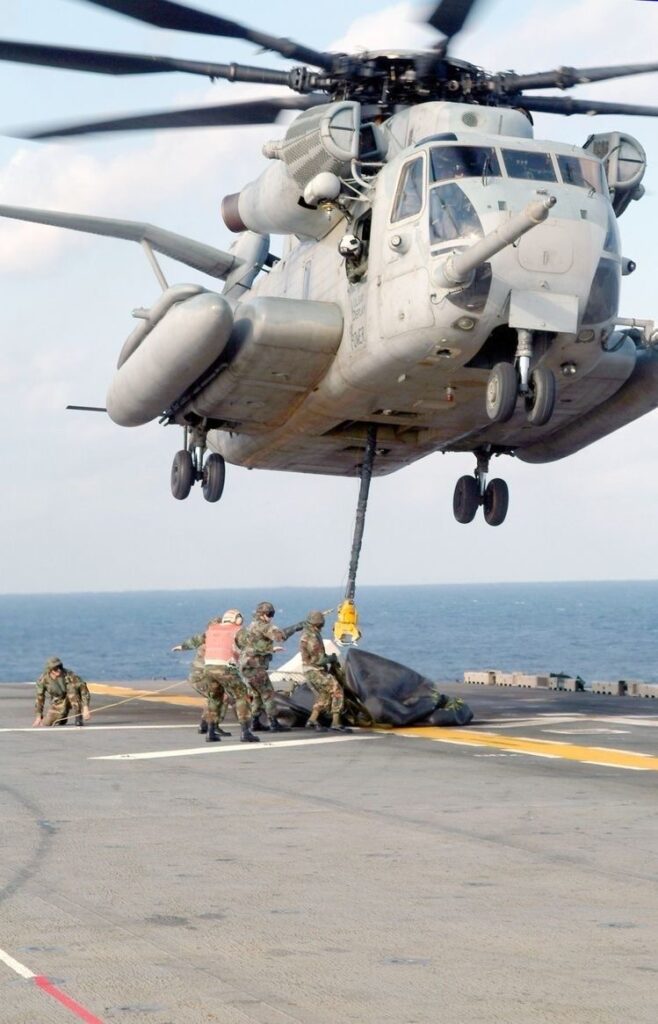
The CH-53E Super Stallion stands as one of the most powerful and versatile heavy-lift helicopters ever built. Designed by Sikorsky Aircraft, this massive machine has served the United States Marine Corps and Navy for decades, becoming a symbol of raw lifting power, resilience, and mission flexibility. Entering service in the early 1980s, the Super Stallion was a direct response to the military’s need for a helicopter capable of carrying immense loads across long distances, even in demanding environments.
At first glance, the CH-53E is an imposing aircraft. With its seven-blade main rotor and distinctive three-engine configuration, it dwarfs most other helicopters on the flight line. Measuring nearly 99 feet in length and standing over 28 feet tall, it is the largest and heaviest helicopter in the U.S. military inventory. Its maximum takeoff weight exceeds 73,000 pounds, a figure that highlights its primary mission: lifting what other helicopters cannot.
The helicopter’s power is generated by three General Electric T64-GE-416/416A turboshaft engines, each producing more than 4,300 shaft horsepower. This immense thrust allows the Super Stallion to carry external loads of up to 36,000 pounds, making it capable of transporting armored vehicles, artillery pieces, or multiple vehicles at once. Inside its cavernous cargo hold, it can accommodate up to 55 troops or a fully loaded Humvee. In many ways, the CH-53E bridges the gap between helicopters and fixed-wing transport aircraft, able to move heavy cargo directly to forward areas where runways may not exist.
Combat operations have proven the value of the Super Stallion time and again. From the deserts of the Middle East to the jungles of Southeast Asia, the CH-53E has delivered supplies, evacuated casualties, and moved vital equipment under fire. Its aerial refueling capability, using an extendable probe, extends its operational range far beyond typical helicopters, allowing it to accompany strike forces deep into contested zones. In humanitarian missions, its lifting ability has been equally important, delivering relief supplies, generators, and even entire vehicles to disaster-stricken areas where ground access is impossible.

Despite its size, the CH-53E remains surprisingly agile. Pilots often remark on its responsiveness, though the complexity of its systems requires skilled crews and diligent maintenance. The helicopter’s survivability features include armor protection, infrared countermeasures, and the ability to operate from ships at sea, where its folding rotors and tail boom make it more manageable for storage aboard aircraft carriers and amphibious assault ships.
However, with great capability comes significant challenges. The Super Stallion is expensive to operate and maintain, earning a reputation for demanding upkeep. Over the years, its age has shown, and the Marine Corps has faced increasing pressure to replace it with a modern alternative. That replacement is the CH-53K King Stallion, which promises even greater lift, improved reliability, and advanced avionics. Still, the CH-53E continues to serve faithfully, proving its worth in missions that no other helicopter can perform.
In the history of rotorcraft, the CH-53E Super Stallion stands as a testament to engineering ambition and operational necessity. It has been the heavy hauler of the fleet, the lifeline of Marines ashore, and the embodiment of strength in the skies. Even as its successor takes shape, the Super Stallion’s legacy remains secure as one of the most formidable helicopters ever to fly.



